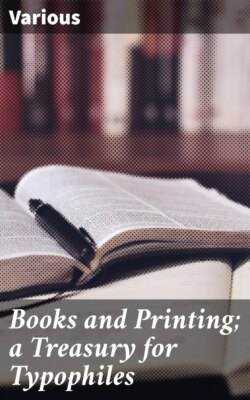Читать книгу Books and Printing; a Treasury for Typophiles - Various - Страница 14
На сайте Литреса книга снята с продажи.
EDWIN ELIOTT WILLOUGHBY Printers' Marks
ОглавлениеTable of Contents
A printer's mark is a trade-mark. Printers used them in the fifteenth, sixteenth and seventeenth centuries for the same purpose that printers employ them today—to ornament their books and to make each volume readily recognizable as the product of the printing establishment which produced it.
The printer's mark was but one of the many types of marks which, largely because of the widespread illiteracy of the people, were used throughout all phases of medieval life. The ownership of objects, for example, was often shown by means of a regularly used mark. Two examples of this type of mark, the seal and the cattle brand, go back to the dawn of history and have continued in use to the present time. Merchants in the Middle Ages often identified their property by placing on it their merchants' marks.
The mark of a merchant was legally recognized as his by his guild or by the town government. Often it was a representation of the tools of the man's trade or a replica of his house sign. Sometimes it was an animal or object which formed a pun on the merchant's name. Frequently, simple geometric designs were used. Toward the latter part of the Middle Ages, as merchants grew richer and more powerful, they aped the upper class by making their marks resemble, as closely as they dared, the heraldic devices of the knights and nobles. These marks enabled employees or hired porters to recognize at a glance a merchant's property.
Places, as well as objects, were identified by means of marks. Inns, shops and similar public places in those days before houses were numbered were designated by house signs. The Tabard, the inn from which Chaucer's pilgrims started for Canterbury under the leadership of its host, Harry Baillie, took its name from its sign—a representation of a short outer jacket. An equally famous tavern, patronized by Shakespeare, Ben Jonson and other "sirenical gentlemen," bore the "Sign of the Mermaid." And over the door of the Globe, Shakespeare's theater, hung a picture of Atlas bearing the world on his shoulders.
Printing houses, like other business establishments, were known by house signs. The printer's mark of Adrien van Berghen supplies an illustration. [Page 48.]
Not only were objects and places designated by marks in the Middle Ages, but under certain conditions people were recognized by them also. A knight, his face obscured by his helmet, made his identity known by wearing on his helmet, shield and tabard simple pictures or symbols by which he could be recognized. As it was usual for members of the same family to wear the same emblems, these simple pictures, many of which became conventionalized, descended from father to son, indicated relationships, and finally developed under the control of officers of the king into the elaborate system of heraldry.
Marks, then, were widely used in the Middle Ages. It was inevitable that they should be used to identify the makers of manufactured goods. Craftsmen with pride in their work naturally desired others to recognize their products. As a result, the use of trade-marks became common. Craftsmen of every trade were frequently compelled either by law or by guild regulations, to affix a mark to their products as a guarantee of their honesty and good workmanship. Such marks were required especially of goldsmiths, silversmiths and other artisans who were under unusual temptation to misrepresent the quality of their goods. In England, to take another example, arrowheads, the quality of which might determine the issue of a battle, were ordered, by a statute of Henry IV, to be "marked with the mark of him who made the same."
These trade-marks performed much the same function as the house mark or the merchant's mark; indeed, the three were often the same. They enabled a purchaser, literate or illiterate, to identify the maker of a product and to buy thereafter according as he had been satisfied or displeased with the first article purchased.
